
Inspection, Testing, and Maintenance of Fire Alarms
The inspection, testing and maintenance requirements of fire alarms systems, including their initiating devices and notification appliances, can be found in Chapter 14 of the National Fire Protection Association’s Code NFPA 72. The purpose for these inspection, testing, and maintenance requirements is to ensure that the fire alarm system is operating properly in accordance with the design documents.
Fire Alarm Visual Inspection Schedule
Visual inspections of fire alarm components are to be done weekly, monthly, semiannually, and/or annually in accordance with the schedules in table 14.3.1 of NFPA 72. These schedules can change depending on the local jurisdiction and the authority having jurisdiction (AHJ). Some of the most common visual inspections include:
- Control equipment must be checked weekly to verify that the fire alarm system is in normal condition. This includes visually inspecting the fuses, LEDs, power supply, and checking for trouble signals.
- Batteries must be inspected on a monthly or semiannual basis (depending on type) for corrosion or leakage.
- Duct detectors, heat detectors, and smoke detectors must be checked on a semiannual basis.
- All equipment must be checked annually to ensure there are no changes that affect equipment performance.
Fire Alarm Testing Schedule
Testing of fire alarm components are much more detailed compared to visual inspections but are scheduled to be done less often. While there are a few components that require semiannual testing, most components require testing annually according to table 14.4.3.2 of NFPA 72. Just like inspections, the testing schedule can change depending on the local jurisdiction and the AHJ. A few of the many component testings include:
- Control equipment must be tested annually to verify correct receipt of alarm, supervisory, and trouble signals. All interfaced equipment must be operated or simulated to verify the signals are transmitted to the control unit.
- Fire alarm control unit trouble signals, both audible and visual, must be tested and verified annually.
- The secondary power supply (backup battery) must be tested by disconnecting all primary power supplies. Batteries must also be tested to verify the voltage level does not fall below the 2.05 volts per cell under load.
- Initiating devices must be tested to ensure they operate according to design and transmit their signal to the control unit. These means heat detectors require a heat test and smoke detectors must be tested with smoke or approved smoke simulant.
- Alarm notification appliances must be tested and verified that they operate correctly audibly and visually.
- Many fire alarms systems are integrated with mass notification systems and other specialized components that also must be tested according to NFPA 72 guidelines.
Fire Alarm Maintenance Schedule
Maintenance of fire alarm components is in accordance with the manufacturer’s published instructions. The frequency or schedule of maintenance is dependent on the type of equipment and environmental conditions. Cleaning of fire alarm system components is also dependent on the environment where the component is installed and according to manufacturer’s guidelines. If any component is replaced or repaired, testing may be required according to the AHJ or table 14.4.3.2 of NFPA 72.
Contact Koorsen for Fire Alarm Inspections, Testing, and Maintenance
Since 1946, businesses of all sizes have depended on Koorsen Fire & Security for their fire and life safety needs. To schedule service or to learn more about inspections, testing and maintenance of fire alarm systems, contact a Koorsen Fire & Security associate today.


